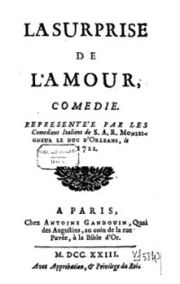
La Surprise de l'amour
Encyclopedia

Romantic Comedy
Romantic Comedy can refer to* Romantic Comedy , a 1979 play written by Bernard Slade* Romantic Comedy , a 1983 film adapted from the play and starring Dudley Moore and Mary Steenburgen...
comedy
Comedy
Comedy , as a popular meaning, is any humorous discourse or work generally intended to amuse by creating laughter, especially in television, film, and stand-up comedy. This must be carefully distinguished from its academic definition, namely the comic theatre, whose Western origins are found in...
by French
French people
The French are a nation that share a common French culture and speak the French language as a mother tongue. Historically, the French population are descended from peoples of Celtic, Latin and Germanic origin, and are today a mixture of several ethnic groups...
playwright Marivaux. Its title is usually translated into English as The Surprise of Love. La Surprise de l'amour was first performed 3 May 1722 by the Comédie Italienne at the Hotel de Bourgogne
Hôtel de Bourgogne
Until the 16th century, the Hôtel de Bourgogne was the name of the Paris residence of the Dukes of Burgundy. Today, the last vestige is the Tour Jean sans Peur, 20 rue Étienne Marcel, in the 2nd arrondissement.-Theatre:...
in Paris. In this play, a man and a woman who've sworn off love are tricked by their servants into falling in love with each other.
Like many of Marivaux's other comedies, La Surprise de l'amour makes use of stock characters from the Commedia dell'arte
Commedia dell'arte
Commedia dell'arte is a form of theatre characterized by masked "types" which began in Italy in the 16th century, and was responsible for the advent of the actress and improvised performances based on sketches or scenarios. The closest translation of the name is "comedy of craft"; it is shortened...
. In this play, Arlequin
Harlequin
Harlequin or Arlecchino in Italian, Arlequin in French, and Arlequín in Spanish is the most popularly known of the zanni or comic servant characters from the Italian Commedia dell'arte and its descendant, the Harlequinade.-Origins:...
and Columbine
Columbina
Columbine is a fictional character in the Commedia dell'Arte. She is Harlequin's mistress, a comic servant playing the tricky slave type, and wife of Pierrot...
are featured.
Théophile Gautier
Théophile Gautier
Pierre Jules Théophile Gautier was a French poet, dramatist, novelist, journalist, art critic and literary critic....
considered this to be Marivaux's finest work.
Plot summary
After having been betrayed by a woman, Lélio renounces love and retires to the countryside with his valet, Arlequin, whose adventures in love are similar. Arlequin, who loves everything about women, including their faults, struggles with the task of forgetting them. One of Lélio's servants, Jacqueline, hopes to marry Pierre, a servant at the nearby home of the countess. Lélio refuses to allow the two to marry, as he imposes his own viewpoint on his entire household.The countess, who herself refuses to love men, comes to intervene. Despite the fact that Lélio and the countess swear not to fall in love, a friend of Lélio predicts that this will come to pass. The countess decides to avoid Lélio, but in doing so, she earns his respect and sets in motion the ideas of her servant Columbine. Through the machinations of Columbine and Arlequin (who in turn fall in love themselves), the countess and Lélio ultimately end up together. The play ends with three happy couples: Lélio and the countess, Arlequin and Columbine, and Pierre and Jacqueline.
Characters
- The countess - a wealthy widow who has sworn off men
- Lélio - a man who has sworn off women
- The baron - a friend of Lélio
- ArlequinHarlequinHarlequin or Arlecchino in Italian, Arlequin in French, and Arlequín in Spanish is the most popularly known of the zanni or comic servant characters from the Italian Commedia dell'arte and its descendant, the Harlequinade.-Origins:...
- Lélio's valet - ColumbineColumbinaColumbine is a fictional character in the Commedia dell'Arte. She is Harlequin's mistress, a comic servant playing the tricky slave type, and wife of Pierrot...
- The countess' confidente - Jacqueline - a female servant in Lélio's household
- Pierre - the countess' gardener
External links
- La Surprise de l'amour, in French from the Bibliothèque Nationale
- La Surprise de l’amour from the French site CÉSAR

